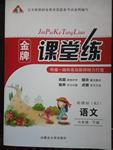题目内容
14.After the earthquake,the whole city _________.( )| A. | destroyed | B. | was destroyed | ||
| C. | had destroyed | D. | had been destroyed |
分析 地震过后,整个城市被破坏了.
解答 答案是B.考查被动语态,根据句意地震已经发生可以判断句子要用过去时,the whole city与动词destroy之间是被动关系,所以用一般过去时的被动语态,故答案选B.
点评 被动语态由"助动词be+及物动词的过去分词"构成.被动语态的时态变化只改变be的形式,过去分词部分不变.疑问式和否定式的变化也如此.掌握各种时态的被动语态是解题的关键.

练习册系列答案
 作业辅导系列答案
作业辅导系列答案 同步学典一课多练系列答案
同步学典一课多练系列答案 经典密卷系列答案
经典密卷系列答案 金牌课堂练系列答案
金牌课堂练系列答案
相关题目
16.-It is very seldom that one would be invited to a British person's home.
-That's true.Whether the person you know is a work colleague or a neighbor,being invited inside their house is quite ______.( )
-That's true.Whether the person you know is a work colleague or a neighbor,being invited inside their house is quite ______.( )
| A. | normal | B. | often | C. | rare | D. | proper |
17.Feeling good about our actions-not guilt or pity-motivates giving,according to the latest research.
(51)Bseeing or hearing about suffering children makes most people uncomfortable,that grief is not what drives them to dig into their pockets and donate.The reasons people decide to be selfless,it turns out,may be slightly more (52)D.
In the study,published in the Journal of Neuroscience,researchers found that people are more likely to give when they think it will make them feel better.They donate,(53)A,when they feel hope about putting smiles on those expectant and suffering faces.And that hope,or similar feel-good sensations,are driven by the brain's reward systems.
Researchers-and charities-have long known that putting a(n) (54)C face on an abstract problem opens hearts and wallets.Josef Stalin once said that while one death is a(n) (55)D,a million is merely a number.Studies have since found that quantifying the size of a disaster or particular need actually (56)C giving,while presenting a single story is more likely to cause a desire to help.
But it wasn't clear whether this"identifiable victim"effect resulted from people's (57)Bover their own privilege and resources-or from a sense of connection with the (58)C and an urge to feel good about making a difference.
To find out,researchers led by Alexander Genevsky,a graduate student in psychology at Stanford,imaged the brains of 22young adults.In the scanner,they saw either a silhouette (剪影) or a head shot of a young African child.As in previous studies,participants were far more likely to give if they saw a face than a blank silhouette-donating almost twice as much in photo trials than in the others.However,this decision was related strongly to their (59)D.If they showed little activity in their nucleus accumbens-a brain region linked to every type of pleasurable experience-they were actually less likely to give.But if there is a sharp (60)Bof activity in this reward area,they felt good and gave more.And the photos of the children were more likely to (61)C this reward center.Activity in the accumbens,in fact,completely (62)C the difference in giving seen between the silhouette-based requests and the photo-based ones.
While the findings point to the feel-good(63)A behind giving,other research will have to address the question of why givers get that positive emotional boost.Do people feel rewarded when they give because they think about the happiness of the recipient-or do they feel good because they see themselves as (64)D and that self-esteem boost (自信心增强) is mood-enhancing?Such information could help charities (65)B their messages to maximize their effectiveness.
(51)Bseeing or hearing about suffering children makes most people uncomfortable,that grief is not what drives them to dig into their pockets and donate.The reasons people decide to be selfless,it turns out,may be slightly more (52)D.
In the study,published in the Journal of Neuroscience,researchers found that people are more likely to give when they think it will make them feel better.They donate,(53)A,when they feel hope about putting smiles on those expectant and suffering faces.And that hope,or similar feel-good sensations,are driven by the brain's reward systems.
Researchers-and charities-have long known that putting a(n) (54)C face on an abstract problem opens hearts and wallets.Josef Stalin once said that while one death is a(n) (55)D,a million is merely a number.Studies have since found that quantifying the size of a disaster or particular need actually (56)C giving,while presenting a single story is more likely to cause a desire to help.
But it wasn't clear whether this"identifiable victim"effect resulted from people's (57)Bover their own privilege and resources-or from a sense of connection with the (58)C and an urge to feel good about making a difference.
To find out,researchers led by Alexander Genevsky,a graduate student in psychology at Stanford,imaged the brains of 22young adults.In the scanner,they saw either a silhouette (剪影) or a head shot of a young African child.As in previous studies,participants were far more likely to give if they saw a face than a blank silhouette-donating almost twice as much in photo trials than in the others.However,this decision was related strongly to their (59)D.If they showed little activity in their nucleus accumbens-a brain region linked to every type of pleasurable experience-they were actually less likely to give.But if there is a sharp (60)Bof activity in this reward area,they felt good and gave more.And the photos of the children were more likely to (61)C this reward center.Activity in the accumbens,in fact,completely (62)C the difference in giving seen between the silhouette-based requests and the photo-based ones.
While the findings point to the feel-good(63)A behind giving,other research will have to address the question of why givers get that positive emotional boost.Do people feel rewarded when they give because they think about the happiness of the recipient-or do they feel good because they see themselves as (64)D and that self-esteem boost (自信心增强) is mood-enhancing?Such information could help charities (65)B their messages to maximize their effectiveness.
| 51.A.Since | B.Although | C.If | D.As |
| 52.A.passive | B.earnest | C.impersonal | D.selfish |
| 53.A.for example | B.on the contrary | C.as a result | D.on the other hand |
| 54.A.plain | B.ugly | C.specific | D.frightened |
| 55.A.accident | B.threat | C.solution | D.tragedy |
| 56.A.ruins | B.stimulates | C.lowers | D.skips |
| 57.A.anger | B.guilt | C.regret | D.joy |
| 58.A.desire | B.mind | C.victim | D.stuff |
| 59.A.actions | B.beliefs | C.images | D.emotions |
| 60.A.edge | B.rise | C.turn | D.division |
| 61.A.monitor | B.target | C.activate | D.interrupt |
| 62.A.resulted from | B.counted on | C.accounted for | D.subjected to |
| 63.A.motivations | B.compliments | C.ambitions | D.requests |
| 64.A.executive | B.justified | C.innocent | D.generous |
| 65.A.conceal | B.tailor | C.obtain | D.delete |
3.When ____ to danger and conflict,men tend to increase blood pressure,______ nervous and anxious.( )
| A. | exposed; felt | B. | exposed; feeling | ||
| C. | exposing; feeling | D. | exposing; felt |